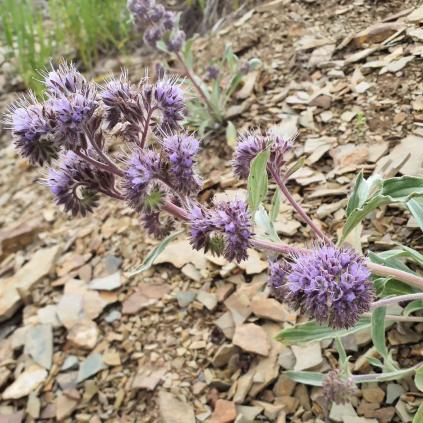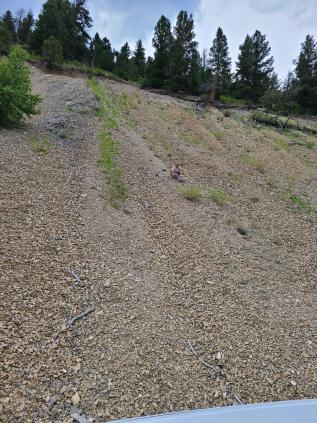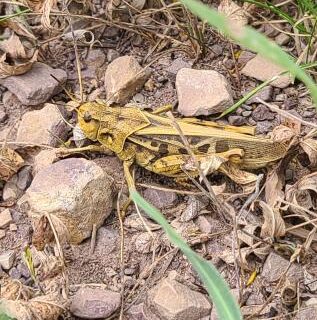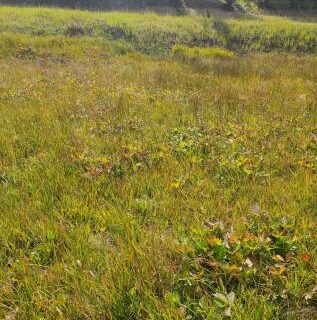Phacelia
Phacelia hastata sits there taunting me. One side still has its purple, curly inflorescence while the other side is dull brown – dried and perfect for collecting. A few more sit just 5 ft away from the first, but all are at least 10 feet above me. Phacelia loves to grow in hard to reach places where there is little competition and plenty of access to the sun. Perfect for the plant, but difficult for the seed collector.
I grab everything I need from the truck – radio, paper bag, a glove – and glance back at the obstacle before me. This specific site was a steep, rocky slope next to the road made up of sheet rock. Slowly and carefully I start climbing the slope. Every two steps I took counted as one as the rocks shifted beneath my weight, but at least I was making progress. I sat low to the ground with my knees on the slope whenever I could in order to keep my center of gravity close to the slope itself and used my hands as additional support as I climbed. I made it to each plant and lightly ran my gloved hand along the dried fruits – allowing some to easily fall into my palm before throwing them into the paper bag. I had to wear a glove for this endeavor because the common name “Scorpionweed” for Phacelia hastata is very fitting as the fruits have hairs that are irritating and prickly to touch. I adjust my footholds and continue to make my way across the slope to the many Phacelia plants growing in this difficult terrain. I volunteered to go up to this height – my partners for today, Madeline and Stella, choosing to collect from the plants lower to the road.
I found this collection to be a fun challenge and enjoyed the accomplished feeling as I successfully transversed the steep slope. Some areas were easier than others. At some points I could stand up and carefully walk diagonally up the slope, while at other points I would slide down a few feet before having to find another path to go on.
By the end of the collection time, I had collected half a paper bag of phacelia fruits/seeds and gotten covered in dust from the slope but felt very accomplished by overcoming the challenge. I was happy to have been able to get the genetics from the higher individuals to include into our collection and happy that I could climb this slope at all – one of the other sites which we wanted to collect Phacelia was even more difficult to climb and we had stayed to just the lower individuals because of this.

August 1, 2023


August 7, 2023
The Grasshopper
*Plop*. A grasshopper hops onto the windshield of our truck. We stop, but it seems as though it has no intention to leave. Slowly, we continue on our path. The grasshopper faces the same way that we are headed, his yellow body braced against the movement of the truck. We make our way past a small meadow and to another forested area when the grasshopper finally hops off of its own volition. I could not help but wonder if it knew what it was doing. If it was just using us as a way to create its own adventure and explore a new area just as we are using this opportunity to explore as well. I can only wish the grasshopper well on its future travels.

Battle of Geum
For a few weeks now, my mentor, Victor, and I have been debating the identification of a specific Geum plant growing outside the office door. In the beginning of the summer, Victor told me that this one was ‘Geum macrophyllum’ which is one of the species on our collection list. At the time I did not question it, but this past month we ran into a couple other Geums that look very similar – especially now that they are fruiting instead of flowering. The three are Geum macrophyllum, Geum aleppicum, and Geum rivale. Rivale flowers are pink and nodding while the flowers of the other two are yellow – allowing easy distinction between the three when there are flowers present but all of their fruits are ‘spiny with achene beaks’ as stated in our plant key and look very similar at a glance. All three of these plants also grow in very similar habitats: moist sites next to rivers. Luckily, even with just fruits the rivale flowers still keep their purple sepals which is the key difference between rivale and the other two and also has the longest achene beaks.
The next step, to separate out macrophyllum, is dependent on whether the lower portion of the style is minutely glandular or not at all. My partner, Tori, and I have had quite a lot of trouble deciding whether something is glandular or not throughout this summer – even with the use of a hand lens – and so while we do check for this step, we also looked to see if there were some other differences between the two. One of the Botany techs on the Helena side of the forest, Nate, responded to this question by saying that the macrophyllum receptacle is hairless while the other two possibilities in the key are not. Those other two being Geum aleppicum and canadense. Canadense is automatically crossed out as an option due to it having white flowers and no known cases of it living in the south west side of Montana – where we are collecting at.
I took Nate’s shortcut and ran with it – informing Victor that our plant outside the door was indeed aleppicum rather than macrophyllum. Victor did not believe me at first – especially since Nate’s difference was not in the key that we used. He looked up pictures and tried to compare the species that way. In the past few weeks, he changed his mind on what species that plant was about 5 times before finally deciding today that I was right. The mystery Geum growing by the office door was indeed Geum allepicum – now added to our collection list along with Geum rivale.

